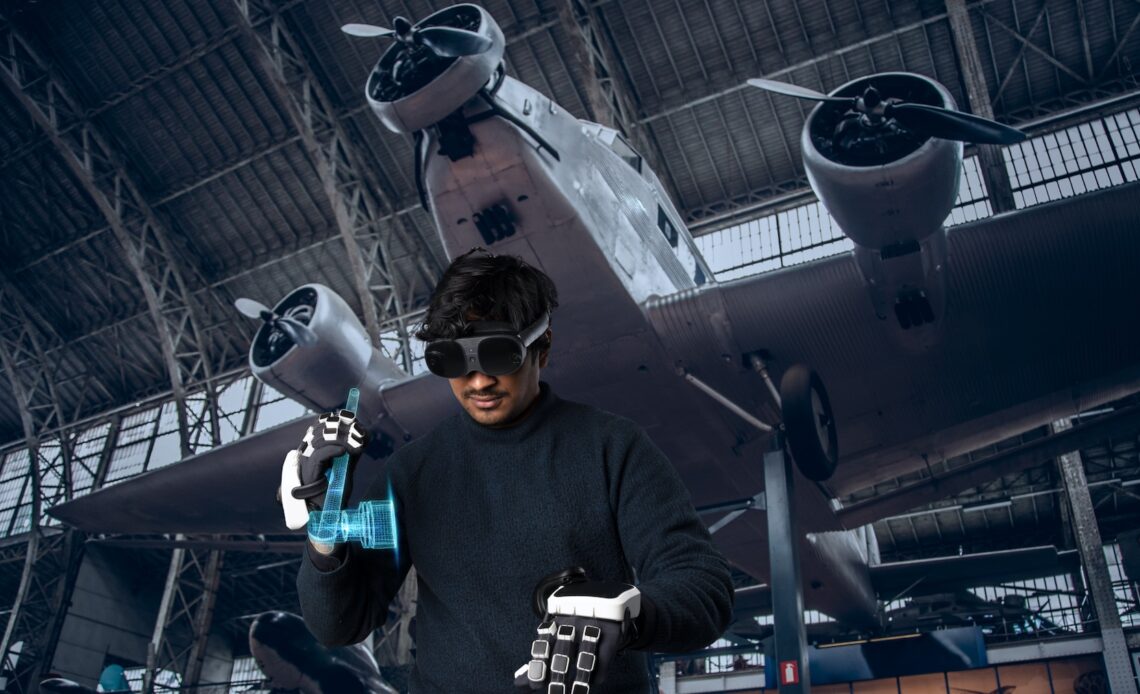
SenseGlove will be presenting its haptic exoskeleton project for robotic teleoperation.
Crédits photos : SenseGlove
For nearly a decade, SenseGlove has been developing haptic technology solutions to enhance interactivity in XR experiences. Every year, as a regular exhibitor at Laval Virtual, SenseGlove impresses visitors with a fresh innovation and a new product. This year, the Dutch company will be showcasing the latest version and third generation of haptic gloves, the Nova 2. The team will also be presenting an exoskeleton project for robot teleoperation.
Can you tell us more about your company?
At SenseGlove, we develop haptic feedback technology. We focus on hand based haptic products that help to train workforce whether these are humans or Robots. We have VR haptic gloves and create custom haptic devices for certain cases, and we have exoskeletons to remotely operate and train Robots.
Our goal is to help companies effectively train their workforce by making virtual interactions more intuitive through the sense of touch. Our gloves offer an enhanced way to train in VR, resulting in much better learning outcomes.
SenseGlove was born in 2017 in Delft, but we are now based in Rotterdam as this city is strongly focused on supporting the development of immersive technologies. Rotterdam is quickly becoming one of Europe’s most important and impactful tech hubs.
What will you exhibit at Laval Virtual?
SenseGlove has exhibited at Laval for well over five years, and in this edition we are proudly showcasing our third generation haptic gloves: the Nova 2. These are the most compact haptic gloves in the market for workforce training, which combine three types of feedback for immersive VR training solutions: force feedback, active contact palm feedback and vibrotactile feedback.
We will also be sharing insights on our most recent project in the works, an exoskeleton haptic solution for teleoperation and robotic workforce training.
Are you planning any activities or demos at your booth?
We will be giving demos of our Nova 2 gloves in our booth, so visitors will get the chance to test out the haptic feedback technology of the Nova 2 in action and learn all about our gloves from our team.
But this year we are also very excited to be offering an informative workshop on April 10, where we will dive into how our haptic gloves can be used to train workforce in XR but also present our progress on our Rembrandt project: a haptic glove for telerobotic solutions.
Do you have innovation insights to share with our visitors?
With our current and future innovations, we are focused on enhancing workforce training in XR. Since 2017, we have been developing haptic solutions that help industries like aviation, healthcare and defense train their human workforce more effectively in XR.
But as we know, we live in a rapidly growing tech-driven society. It is a fact that the workforce of the future will not only consist of humans. We are seeing a growing presence of humanoid robots and physical AI in the workplace, and this workforce also needs training.
So what has guided our product development for the Nova 2, but also for our upcoming solution for humanoid robot training, is offering an optimal training tool that meets the current and future training needs of industries.
How is your solution transforming your business field?
Within the VR and XR training sector, our haptic gloves are helping companies get real and better learning results from training in virtual scenarios.
Traditional VR controllers don’t offer realistic interactions. You push a button, or in the best case, you make a gesture to interact. But this is not how we interact in real life. These non-realistic interactions reduce the quality of XR training.
With the Nova 2 gloves, users can interact intuitively in virtual environments. And the haptic feedback from the gloves give the brain the essential cues it needs to focus on the training and create muscle memory to increase skill retention and performance.
Sustainability and the environment are key topics of this century. How do you cope with these concerns in your XR technologies?
We are very aware of how traditional industry training inevitably requires using a large amount of resources. The carbon footprint of traditional training can be quite high, especially when considering everything that needs to happen to facilitate in-person training: moving personnel to training facilities, developing real-life situations and scenarios with props, or physical resource waste during training.
One of the most important benefits we see in XR training is precisely the drastic reduction of physical resources required. Training with VR haptics makes training resource-effective and scalable, and this is how we envision all training should be. We want to continue working towards developing haptic solutions that make training not only safe, but also sustainable in all aspects.



